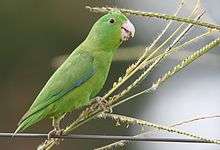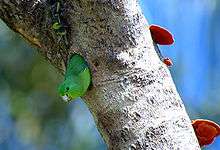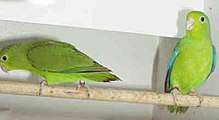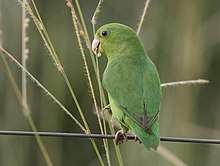Blue-winged parrotlet
The blue-winged parrotlet (Forpus xanthopterygius) is a species of parrot in the family Psittacidae. It is the nominate species (F. x. xanthopterygius).
| Blue-winged parrotlet | |
|---|---|
 | |
| Male in Goias, Brazil | |
| Scientific classification | |
| Kingdom: | Animalia |
| Phylum: | Chordata |
| Class: | Aves |
| Order: | Psittaciformes |
| Family: | Psittacidae |
| Genus: | Forpus |
| Species: | F. xanthopterygius |
| Binomial name | |
| Forpus xanthopterygius (Spix, 1824) | |
| Subspecies | |
| |
There are two subspecies: Salvadori's blue-winged parrotlet (F. x. flavescens) and Hellmayr's blue-winged parrotlet (F. x. flavissimus).[2]
Description
| Name | Appearance | Range |
|---|---|---|
| blue-winged parrotlet
(Forpus xanthopterygius xanthopterygius) (nominate species) |
Typically around 12 centimetres (4.7 in) long and weigh about 28 grams (0.99 oz). Primarily green or olive green with light peach beaks and feet and dark brown eyes, which are surrounded by bright green. Blue-winged parrotlets are sexually dimorphic: males have purple-blue primary, secondary, and underwing coverts with bright blue patch on rump. Females have no blue markings and yellow-green foreheads.[2] Like all parrots, blue-winged parrotlets exhibit zygodactyly, meaning two toes face forward and two face backward.
Juveniles look like adults, except males have green feathers mixed in with their blue markings. |
northeastern Argentina (Misiones, northeastern Corrientes, eastern Chaco, eastern Formosa), from Paraguay north through central/mideastern Brazil to northern Bahia[2] |
| Salvadori's blue-winged parrotlet
(F. x. flavescens) |
Compared to the nominate species, both males and females are more yellow-green or paler in color. Males have paler blue markings on wings and more yellow-green foreheads, cheeks, and underparts.[2] | mideastern Peru south to eastern Bolivia (Beni, Santa Cruz)[2] |
| Hellmayr's blue-winged parrotlet
(F. x. flavissimus) |
Both males and females are more yellow-green or paler in color. Males have more yellow-green foreheads, cheeks, and throats.[2] | northeastern Brazil from Maranhão, Ceará, Paraiba south to northern Bahia[2] |
Distribution and habitat

Blue-winged parrotlets are found in much of central and northern South America. Their range is split by each subspecies, as described above. It is generally common and widespread, though more localized in the Amazon Basin.
Blue-winged parrotlets are mainly found in lowlands. They occur in dry and riparian woodlands, cerrado, caatinga, palm groves, semi-arid scrubland, savanna, and pastures.[2] Blue-winged parrotlets tend to avoid densely forested areas. They are not found at altitudes above 1,200 metres (3,900 ft).[3]
Blue-winged parrotlets are generally non-migratory; however, populations in Argentina move locally according to the flowering seasons of various plant species in their diet. Populations in the Brazilian Atlantic Forest are altitudinal migrants.[4]
Conservation
The number of blue-winged parrotlets is unknown, but the population is stable. It is listed as Least Concern by the IUCN Red List.[1] The number of wild individuals is unknown.
Behavior and ecology

Social
Flocks are usually around 20 birds but can grow to over 50 around fruiting trees or seeding grasses. They are highly social and gregarious.[4][6] Blue-winged parrotlets tend to feed in groups, usually between 2 and 12 individuals.[7]
Blue-winged parrotlets call while in flight and perched. Their calls are high-pitched "sheet" or "zeet" screeches or twittering.[6][8] When feeding and socializing in large groups they make twittering and chattering noises.[2]
Reproduction
Blue-winged parrotlets' breeding season is May to August, but occupied nests have been observed in July, January, and March in different areas of the birds' range.[8] Females lay 3-7 small, white, roughly spherical eggs.[2] Some blue-winged parrotlets have been observed to scrape rufous hornero nests (made of clay) with their beaks. Though the reason for this is not entirely clear, nests created by rufous horneros have been used by blue-winged parrotlets to raise their broods, which has led to the suggestion that the parrotlets are "taste-testing" the nest material to determine whether it is suitable, according to unknown standards, for their needs.[9] However, similar studies of other Forpus species have concluded that clay-licking provides important minerals to the birds that otherwise would not be accessible.
Diet
Blue-winged parrotlets mostly feed on Cecropia sp. and Ficus sp.[10] fruits, Mikania sp. and Trema micrantha seeds, and Ambrosia sp., Handroanthus serratifolius,[7] and Marcgravia sp. flowers. However, they are known to occasionally feed on other plants such as grass.[2] Blue-winged parrotlets have been known to migrate locally based on the flowering and fruiting seasons of some of the main plants of their diet.[8]
Taxonomy
For many years, the blue-winged parrotlet was considered conspecific with the green-rumped parrotlet (Forpus passerinus), but today all authorities recognize the two as separate species. The turquoise-winged parrotlet (F. spengeli) and the large-billed parrotlet (F. crassirostris) were also considered conspecific with the blue-winged parrotlet until studies in 2015 pointed out the error in this classification based on morphological and geographical differences.[11] However, some taxonomic authorities, including the American Ornithological Society, still consider them so.
The blue-winged parrotlet is a rare case in which the common name has been more stable than the binomial. F. xanthopterygius initially referred to what are now considered two distinct species: the blue-winged parrotlet and the white-winged parakeet (Brotogeris versicolurus). In 1945, the Brazilian ornithologist Olivério Pinto discarded the name F. xanthopterygius for the blue-winged parrotlet and renamed it F. crassirostris (which now applies to the closely related large-billed parrotlet). During the same year, the blue-winged parrotlet was mistakenly recorded as F. xanthopterygius crassirostris and was again reverted to F. xanthopterygius. In 1978, Pinto mentioned the mistake in Novo Catálogo das Aves do Brazil and the name was changed to F. crassirostris. However, as was pointed out in 1999, the original name (F. xanthopterygius) remains valid per ICZN rules. Consequently, this name was re-applied to the blue-winged parrotlet. Additionally, the name of the nominate subspecies also changed: F. x. xanthopterygius is the subspecies formerly listed as F. crassirostris vividus.
References
- BirdLife International (2012). "Forpus xanthopterygius". IUCN Red List of Threatened Species. 2012. Retrieved 26 November 2013.CS1 maint: ref=harv (link)
- "Blue-winged Parrotlet (Forpus xanthopterygius) | Parrot Encyclopedia". www.parrots.org. Retrieved 2019-03-17.
- Parr, M.; Juniper, T. (2010). Parrots: A Guide to Parrots of the World. A&C Black. p. 176. ISBN 978-1408135754.
- "Blue-winged Parrotlet - Introduction | Neotropical Birds Online". neotropical.birds.cornell.edu. Retrieved 2019-03-17.
- "The IUCN Red List of Threatened Species". IUCN Red List of Threatened Species. Retrieved 2019-03-17.
- "Blue-winged Parrotlet - eBird". ebird.org. Retrieved 2019-04-05.
- Melo, C.; Oliveira, A.D.; Borges, C.A.; Ribeiro, G.; Tavares, J. (November 2009). "Impact of Forpus xanthopterygius (Spix, 1824) (Aves, Psittacidae) on flowers of Handroanthus serratifolius (Vahl.) S. O. Grose (Bignoniaceae)". Brazilian Journal of Biology. 69 (4): 1149–51. doi:10.1590/S1519-69842009000500020. PMID 19967187.
- "Blue-winged Parrotlet (Forpus xanthopterygius)". www.hbw.com. Retrieved 2019-04-05.
- Sazima, I. (September 2008). "The parrotlet Forpus xanthopterygius scrapes at clay nests of the ovenbird Furnarius rufus: tasting or testing a new home?" (PDF). Revista Brasileira de Ornitologia. 16: 256–259.
- de Figueiredo, R.A. (1996). "Vertebrates at neotropical fig species in a forest fragment". Tropical Ecology. International Society for Tropical Ecology. 37 (1): 139–141 – via ResearchGate.
- Bocalini, F.; Silveira, L.F. (May 2015). "Morphological variability and taxonomy of the Bluewinged Parrotlet Forpus xanthopterygius (Psittacidae)". Revista Brasileira de Ornitologia. 23: 64–75. doi:10.1007/bf03544290 – via ResearchGate.
External links
- World Parrot Trust Parrot Encyclopedia: species profile
- Birdphotos.com: map of range
- Neotropical Birds by Cornell Lab of Ornithology: species profile and media
- eBird by Cornell Lab of Ornithology: species profile and media

